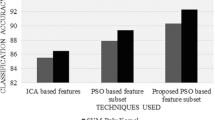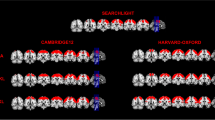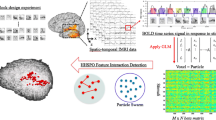Abstract
The multi-voxel pattern analysis technique is applied to fMRI data for classification of high-level brain functions using pattern information distributed over multiple voxels. In this paper, we propose a classifier ensemble for multiclass classification in fMRI analysis, exploiting the fact that specific neighboring voxels can contain spatial pattern information. The proposed method converts the multiclass classification to a pairwise classifier ensemble, and each pairwise classifier consists of multiple sub-classifiers using an adaptive feature set for each class-pair. Simulated and real fMRI data were used to verify the proposed method. Intra- and inter-subject analyses were performed to compare the proposed method with several well-known classifiers, including single and ensemble classifiers. The comparison results showed that the proposed method can be generally applied to multiclass classification in both simulations and real fMRI analyses.







Similar content being viewed by others
References
McKeown MJ, Makeig S, Brown GG, Jung TP, Kindermann SS, Bell AJ, et al. Analysis of fMRI data by blind separation into independent spatial components. Hum Brain Mapp 1998, 6: 160–188.
Calhoun VD, Adali T, Pearlson GD, Pekar JJ. Spatial and temporal independent component analysis of functional MRI data containing a pair of task-related waveforms. Hum Brain Mapp 2001, 13: 43–53.
van de Ven VG, Formisano E, Prvulovic D, Roeder CH, Linden DEJ. Functional connectivity as revealed by spatial independent component analysis of fMRI measurements during rest. Hum Brain Mapp 2004, 22: 165–178.
Lowe MJ, Dzemidzic M, Lurito JT, Mathews VP, Phillips MD. Correlations in low-frequency BOLD fluctuations reflect cortico-cortical connections. Neuroimage 2000, 12: 582–587.
Hampson M, Peterson BS, Skudlarski P, Gatenby JC, Gore JC. Detection of functional connectivity using temporal correlations in MR images. Hum Brain Mapp 2002, 15: 247–262.
Greicius MD, Krasnow B, Reiss AL, Menon V. Functional connectivity in the resting brain: A network analysis of the default mode hypothesis. Proc Natl Acad Sci U S A 2003, 100: 253–258.
Di Martino A, Scheres A, Margulies DS, Kelly AMC, Uddin LQ, Shehzad Z, et al. Functional connectivity of human striatum: A resting state fMRI study. Cereb Cortex 2008, 18: 2735–2747.
Wang Z, Yuan Y, Bai F, Shu H, You J, Li L, et al. Altered functional connectivity networks of hippocampal subregions in remitted late-onset depression: a longitudinal resting-state study. Neurosci Bull 2015, 31: 13–21.
Haxby JV, Gobbini MI, Furey ML, Ishai A, Schouten JL, Pietrini P. Distributed and overlapping representations of faces and objects in ventral temporal cortex. Science 2001, 293: 2425–2430.
Kamitani Y, Tong F. Decoding the visual and subjective contents of the human brain. Nat Neurosci 2005, 8: 679–685.
Norman KA, Polyn SM, Detre GJ, Haxby JV. Beyond mind-reading: multi-voxel pattern analysis of fMRI data. Trends Cogn Sci 2006, 10: 424–430.
Peelen MV, Downing PE. Using multi-voxel pattern analysis of fMRI data to interpret overlapping functional activations. Trends Cogn Sci 2007, 11: 4–5.
Kuncheva LI, Rodriguez JJ, Plumpton CO, Linden DEJ, Johnston SJ. Random subspace ensembles for fMRI classification. IEEE Trans Med Imaging 2010, 29: 531–542.
Hanke M, Halchenko YO, Sederberg PB, Hanson SJ, Haxby JV, Pollmann S. PyMVPA: a python toolbox for multivariate pattern analysis of fMRI data. Neuroinformatics 2009, 7: 37–53.
Pereira F, Mitchell T, Botvinick M. Machine learning classifiers and fMRI: A tutorial overview. Neuroimage 2009, 45: S199–S209.
Kuncheva LI, Rodriguez JJ. Classifier ensembles for fMRI data analysis: an experiment. Magn Reson Imaging 2010, 28: 583–593.
Mahmoudi A, Takerkart S, Regragui F, Boussaoud D, Brovelli A. Multivoxel pattern analysis for fMRI data: A review. Comput Math Methods Med 2012, 2012: 961257.
Guyon I, Weston J, Barnhill S, Vapnik V. Gene selection for cancer classification using support vector machines. Mach Learn 2002, 46: 389–422.
Cristianini N, Shawe-Taylor J. An Introduction to Support Vector Machines. Cambridge: Cambridge University Press, 1999.
Dosenbach NUF, Nardos B, Cohen AL, Fair DA, Power JD, Church JA, et al. Prediction of individual brain maturity using fMRI. Science 2010, 329: 1358–1361.
Genuer R, Poggi JM, Tuleau-Malot C. Variable selection using random forests. Pattern Recognit Lett 2010, 31: 2225–2236.
Furnkranz J. Round robin classification. J Mach Learn Res 2002, 2: 721–747.
Furnkranz J. Pairwise classification as an ensemble technique. Mach Learn: ECML 2002 2002, 2430: 97–110.
Wu TF, Lin CJ, Weng RC. Probability estimates for multi-class classification by pairwise coupling. J Mach Learn Res 2004, 5: 975–1005.
Li T, Zhang C, Ogihara M. A comparative study of feature selection and multiclass classification methods for tissue classification based on gene expression. Bioinformatics 2004, 20: 2429–2437.
Silva H, Fred A. Pairwise vs global multi-class wrapper feature selection. Proceedings of the 6th Conference on 6th WSEAS Int. Conf. on Artificial Intelligence, Knowledge Engineering and Data Bases 2007, 6: 1–6.
Ji H, Bang S. Feature selection for multi-class classification using pairwise class discriminatory measure and covering concept. Electronics Lett 2000, 36: 524–525.
Chen B, Li GZ, You M. Multi-class feature selection using pairwise-class and all-class techniques. IEEE International Conference on Bioinformatics and Biomedicine Workshops (BIBMW) 2010, 644–647.
Haynes JD, Sakai K, Rees G, Gilbert S, Frith C, Passingham RE. Reading hidden intentions in the human brain. Curr Biol 2007, 17: 323–328.
Stokes M, Thompson R, Cusack R, Duncan J. Top-down activation of shape-specific population codes in visual cortex during mental imagery. J Neurosci 2009, 29: 1565–1572.
Coutanche MN, Thompson-Schill SL, Schultz RT. Multi-voxel pattern analysis of fMRI data predicts clinical symptom severity. Neuroimage 2011, 57: 113–123.
Kriegeskorte N, Goebel R, Bandettini P. Information-based functional brain mapping. Proc Natl Acad Sci U S A 2006, 103: 3863–3868.
Rosenblatt M. Remarks on some nonparametric estimates of a density function. Ann Mathematical Stat 1956, 27: 832.
Parzen E. On estimation of a probability density function and mode. Ann Mathematical Stat 1962, 33: 1065.
Silverman BW. Density Estimation for Statistics and Data Analysis. London: Chapman & Hall, 1986.
Friedman J, Hastie T, Tibshirani R. Regularization paths for generalized linear models via coordinate descent. J Stat Softw 2010, 33: 1–22.
Kampa K, Mehta S, Chou CA, Chaovalitwongse WA, Grabowski TJ. Sparse optimization in feature selection: application in neuroimaging. Int J Neural Syst 2014, 59: 439–457.
Witten IH, Frank E. Data Mining: Practical Machine Learning Tools and Techniques. 2nd ed. San Francisco: Morgan Kaufmann, 2005.
Schreiber K, Krekelberg B. The statistical analysis of multi-voxel patterns in functional imaging. PLoS One 2013, 8: e69328.
Liao CH, Worsley KJ, Poline JB, Aston JAD, Duncan GH, Evans AC. Estimating the delay of the fMRI response. Neuroimage 2002, 16: 593–606.
Wilcoxon F. Individual comparisons by ranking methods. Biometrics Bull 1945, 1: 80–83.
Siegel S. Non-Parametric Statistics for the Behavioral Sciences. New York: McGraw-Hill, 1956.
Holmes CJ, Hoge R, Collins L, Woods R, Toga AW, Evans AC. Enhancement of MR images using registration for signal averaging. J Comput Assist Tomogr 1998, 22: 324–333.
De Martino F, Valente G, Staeren N, Ashburner J, Goebel R, Formisano E. Combining multivariate voxel selection and support vector machines for mapping and classification of fMRI spatial patterns. Neuroimage 2008, 43: 44–58.
Takerkart S, Auzias G, Thirion B, Ralaivola L. Graph-based inter-subject pattern analysis of fMRI data. PLoS One 9(8): 104586.
Author information
Authors and Affiliations
Corresponding author
Electronic supplementary material
Below is the link to the electronic supplementary material.
Rights and permissions
About this article
Cite this article
Kim, E., Park, H. Pairwise Classifier Ensemble with Adaptive Sub-Classifiers for fMRI Pattern Analysis. Neurosci. Bull. 33, 41–52 (2017). https://doi.org/10.1007/s12264-016-0077-y
Received:
Accepted:
Published:
Issue Date:
DOI: https://doi.org/10.1007/s12264-016-0077-y




